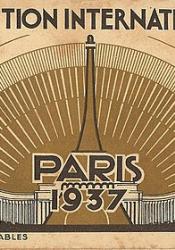Exposition Internationale des Arts et Techniques dan la Vie Moderne
The Exposition Internationale des Arts et Techniques dan la Vie Monderne was an art exhibit that was held from May to Nov of 1937 in Paris. The exhibit was filled with many pavilions which represented different countries around the world. Each pavilion had different pieces of art displayed, some conveying underlying political messages. The German pavilion for example, was decorated with an eagle and a swastika— symbols of the Nazi authorial. The rest of the pavilion had art honoring Nazi Germany and their “achievements.” Facing the German pavilion was the Soviet pavilion. Further illustrating the conflict between the two countries. The exhibit showed lots of dualism: Paris vs its provinces, socialism vs capitalism, fascism vs democracy, etc. Picasso’s “Guernica” was a piece on the terror of war, and was displayed in the Spanish pavilion. “Guernica” was a heart wrenching piece for many due to the violence from the Spanish Civil War. Many pieces in the exhibit gave insight on what was going on in the world. Due to his paintings becoming more renowned and recognizable Picasso started to gain more popularity. This recognition led to more anticipation for his art pieces. Although “Dora Maar” wasn’t in the exposition, it gave more exposure to Picasso.
https://en.wikipedia.org/wiki/Exposition_Internationale_des_Arts_et_Techniques_dans_la_Vie_Moderne
http://www.worldexhibition.org/the_first_worldexpo/1937-paris/
Explanation:
I elaborated background on each of these events because it is helpful to understand how influential small things can be in a sociohistorical context. Picasso painted Dora in 1937 mainly because they were dating but also because he wanted her beauty to be seen. Although he painted her abstractly, I think that there is a lot of substance within her portraits. Picasso later paints Dora as the Weeping Woman, a woman continuously depicted mourning. As stated before, there is duality in Dora’s face. She appears to have two faces that seem relatively apathetic. One is looking directly at the audience, and the other is almost looking inward. As previously stated, the face looking towards the audience can be a universal reflection onto women. It makes a woman question her place in the world. What are they confined to and what can they do to break out of it? The eye looking inward is seen as self evaluation. As we look in, we start to see her true flaws and pain. The bars that surround her are the emotional and physical confinements experienced as a woman but also as Picasso’s partner. The exposition allows the audience to further understand that there are always multiple perspectives to one story. The war has similar implications, there were two sides to the war, each having their own sets of values and beliefs. The tumultuous relationship with Picasso shows the further duplexity of the painting. She loves him so she stays with him, despite him being terrible to her.

